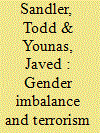|
|
|
Sort Order |
|
|
|
Items / Page
|
|
|
|
|
|
|
| Srl | Item |
| 1 |
ID:
143343


|
|
|
|
|
| Summary/Abstract |
This article reinvestigates the relationship between real per capita gross domestic product (GDP) and terrorism. We devise a terrorism Lorenz curve to show that domestic and transnational terrorist attacks are each more concentrated in middle-income countries, thereby suggesting a nonlinear income–terrorism relationship. Moreover, this point of concentration shifted to lower income countries after the rising influence of the religious fundamentalist and nationalist/separatist terrorists in the early 1990s. For transnational terrorist attacks, this shift characterized not only the attack venue but also the perpetrators’ nationality. The article then uses nonlinear smooth transition regressions to establish the relationship between real per capita GDP and terrorism for eight alternative terrorism samples, accounting for venue, perpetrators’ nationality, terrorism type, and the period. Our nonlinear estimates are shown to be favored over estimates using linear or quadratic income determinants of terrorism. These nonlinear estimates are robust to additional controls.
|
|
|
|
|
|
|
|
|
|
|
|
|
|
|
|
| 2 |
ID:
106024


|
|
|
|
|
| Publication |
2011.
|
| Summary/Abstract |
This article devises a method to separate the Global Terrorism Database (GTD) into transnational and domestic terrorist incidents. This decomposition is essential for the understanding of some terrorism phenomena when the two types of terrorism are hypothesized to have different impacts. For example, transnational terrorism may have a greater adverse effect than domestic terrorism on economic growth. Moreover, the causes of the two types of terrorism may differ. Once the data are separated, we apply a calibration method to address some issues with GTD data - namely, the missing data for 1993 and different coding procedures used before 1998. In particular, we calibrate the GTD transnational terrorist incidents to ITERATE transnational terrorist incidents to address GTD's undercounting of incidents in much of the 1970s and its overcounting of incidents in much of the 1990s. Given our assumption that analogous errors characterize domestic terrorist events in GTD, we apply the same calibrations to adjust GTD domestic incidents. The second part of the article investigates the dynamic aspects of GTD domestic and transnational terrorist incidents, based on the calibrated data. Contemporaneous and lagged cross-correlations for the two types of terrorist incidents are computed for component time series involving casualties, deaths, assassinations, bombings, and armed attacks. We find a large cross-correlation between domestic and transnational terrorist incidents that persists over a number of periods. A key finding is that shocks to domestic terrorism result in persistent effects on transnational terrorism; however, the reverse is not true. This finding suggests that domestic terrorism can spill over to transnational terrorism, so that prime-target countries cannot ignore domestic terrorism abroad and may need to assist in curbing this homegrown terrorism.
|
|
|
|
|
|
|
|
|
|
|
|
|
|
|
|
| 3 |
ID:
152115


|
|
|
|
|
| Summary/Abstract |
This article investigates whether gender imbalance may be conducive to domestic terrorism in developing countries. A female-dominated society may not provide sufficient administration, law, or order to limit domestic terrorism, especially since societies in developing countries primarily turn to males for administration, policing, and paramilitary forces. Other economic considerations support female imbalance resulting in grievance-generated terrorism. Because male dominance may also be linked to terrorism, empirical tests are ultimately needed to support our prediction. Based on panel data for 128 developing countries for 1975 to 2011, we find that female gender imbalance results in more total and domestic terrorist attacks. This female gender imbalance does not affect transnational terrorism in developing countries or domestic and transnational terrorism in developed countries. Further tests show that gender imbalance affects terrorism only when bureaucratic institutions are weak. Many robustness tests support our results.
|
|
|
|
|
|
|
|
|
|
|
|
|
|
|
|
| 4 |
ID:
121791


|
|
|
|
|
| Publication |
2013.
|
| Summary/Abstract |
Terrorists choose from a wide variety of targets and attack methods. Unlike past literature, this article investigates how diversity in target choice and attack modes among domestic and transnational terrorists has evolved and changed over the past 40 years. Changes in the practice of homeland security, which affects the marginal costs of target-attack combinations, and changes in the dominant terrorist influence at the global level, which affects the marginal benefits of target-attack combinations, drive the changepoints. Our empirical analysis relies on count data drawn from the Global Terrorism Database (GTD) for 1970-2010 that distinguishes between domestic and transnational terrorist incidents. Given the data-intensity requirements of our methods, the study is necessarily from a global perspective. A Bayesian Reversible Jump Markov chain Monte Carlo (RJMCMC) changepoint analysis is applied to identify arrival rate changes in both domestic and transnational terrorism. The changepoints in these aggregate series are then matched with those of the subset time series for attack modes (e.g. assassinations and bombings) and target types (e.g. officials and private parties). The underlying drivers of these changepoints are then identified. The article also calculates a Herfindahl index of attack diversity for the aggregate and component domestic and transnational terrorism time series for the entire period and during four subperiods. The variation in both domestic and transnational terrorist attacks has generally fallen over the last four decades; nevertheless, this diversity still remains high. Bombings of private parties have become the preferred target-attack combination for both transnational and domestic terrorists. This combination is the hardest-to-defend target-attack combination and requires the most homeland security resources. Policymakers can use these and other results to focus their counter-terrorism measures.
|
|
|
|
|
|
|
|
|
|
|
|
|
|
|
|
|
|
|
|
|